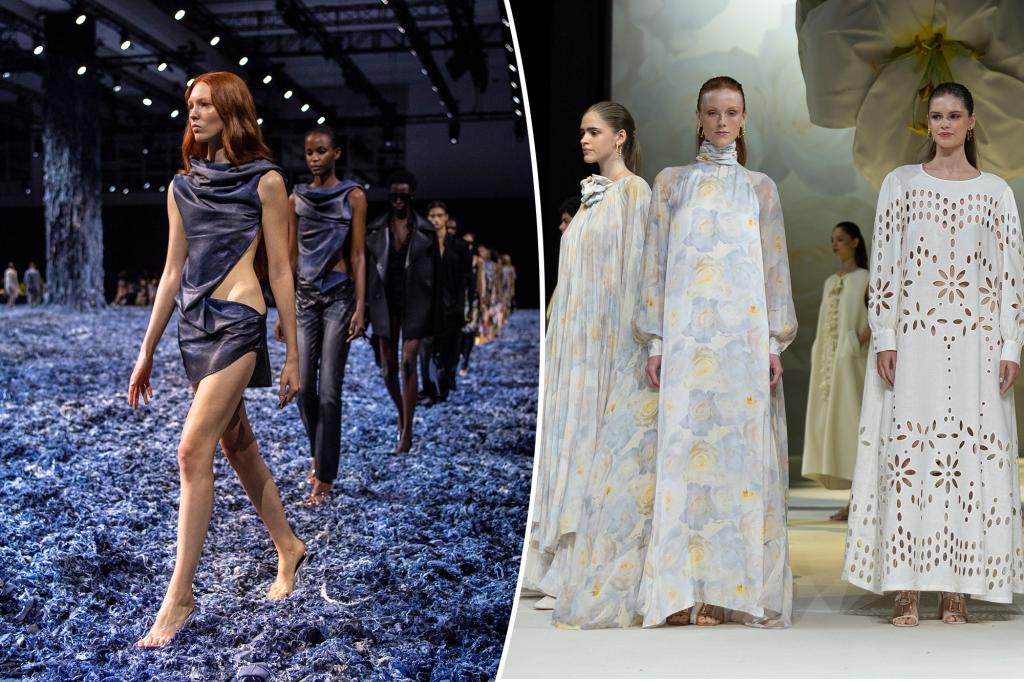They’re not cat-walking the stroll.
Regardless of calls lately for plus-size inclusion on runways, a current slew of style weeks across the globe revealed a notable backing away from the current business development towards physique positivity — with insiders are decrying the transfer as “disheartening.”
The shift comes as stylish weight reduction medication like Ozempic are bringing skinny stylish again, some say — with designers even controversially referencing the phenomenon of their reveals this yr.
A brand new report revealed by Vogue Enterprise discovered that lower than 1% of the 8,763 seems to be proven at 208 shows between New York, London, Milan and Paris this season have been worn by plus-size fashions, which is a US measurement 14 or bigger.
In the meantime, 4.3% have been mid-size, a US measurement 6-12, and almost 95% have been straight-size, a US measurement 0-4.
The findings mirrored final yr’s, per the report, however insiders like Dazed style options director Emma Davidson discovered 2024 to be the “worst season” for illustration “in a very long time.”
“It has felt like manufacturers have been turning their again on inclusive casting for some time, however this season, I sat in my seat just a few instances at reveals the place greater fashions had beforehand been current, and it was so disheartening to see no illustration — this season feels just like the nail within the coffin,” she informed the outlet.
The seems to be from cult-followed “it” manufacturers like Coperni and Miu Miu sat at 0% for plus-size runway seems to be, whereas Ester Manas and Rick Owns landed first and second place, respectively, for plus-size runway illustration in Paris. In the meantime, Milan was the least measurement inclusive and London was probably the most.
In New York, solely 4 of the highest 10 manufacturers included any plus-size fashions in any respect, which Vogue reported is lower than final season.
Some fashionistas aren’t even making an attempt to cover their affection for the toothpick look — on TikTok, footage of a Balmain mannequin from this season is captioned, “the skinniest mannequin ever,” and viewers praised her seems to be for being “unreal,” “perfection” and “aspirational,” calling her a “actual mannequin.”
“It seems like we’ve taken 10 steps backwards,” Anna Shillinglaw, founding father of the modelling company Milk Administration, informed The Guardian.
“I now really feel that a number of the higher-end designers checked out curvier girls extra as a fad in style slightly than one thing that’s actual life,” she mused.
Casting director Emma Matell additionally informed the outlet that she has witnessed “unwell” fashions arrive at reveals “exhausted, shivering or their lips are blue.”
Manchester mannequin Emily McGrail, 21, informed The Guardian that she “felt ‘fats’” compared to different fashions when casting for catwalks, regardless of being “thought of underweight” for her top and age. The lean mannequin even admitted she felt “massive” standing subsequent to the opposite ladies within the room.
“Fashions can stroll right into a room and be rejected 10 to fifteen instances in sooner or later. If that occurs to you, you’re going to wish to change your self,” Matell informed The Guardian. “Subsequent season you’re going to need it to go higher. And searching on the runway proper now, you may assume which means reducing weight.”
Off the catwalk, the development in the direction of thinness picked up as celebrities notoriously began to slim down — followers speculated that the Kardashians, for one, have been minimizing their curves.
And now, plastic surgeons say the “ballet physique,” marked by an athletic, slender body, is the brand new “development.”
To not point out, in fact, the burden loss drug growth.
The recognition of Ozempic has spurred shortages, illicit secondhand promoting on-line and an increase in harmful dupes, whereas the jab has additionally impressed Halloween costumes.
“We’ve gone again to the way in which issues have been 10 years in the past,” former casting director James Scully informed The Guardian.
“These fashions are simply serving a goal. They’re not right here to carry any form of character or pleasure or promote something. They’re again to being a garments hanger.”
